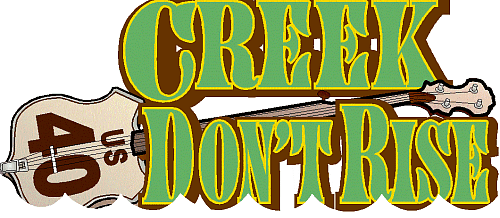



|
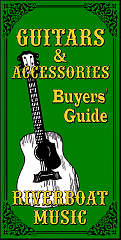

| Written by Paul Race for Creek Don't Rise? |
Editor's Note:
I first investigated banjo pickups in 2012. Since then I have tried several kinds, and I'm still investigating. Unfortunately, my original, chatty article - which has been read by by thousands of people and helped hundreds, has grown a little long in the tooth. This version will leave out all the autobiographical stuff and just report on what's available, and which products work the best for which application.
Banjo Pickups
There are really only a handful of ways to convert sound waves your banjo puts out into an elecrical signal that can e amplified. So, no matter what the manufacturers claim, the technology they use will have certain characteristics. In many cases, two solutions that use the same technology will work out about the same even if one is several times as expensive as the other. So before you assume you need a specific banjo pickup, it helps if you understand what these technologies are and just what you are paying for.
How Pickups Work
Looking at aftermarket pickups, I discovered that most of them use a piezoelectric element fastened to the inside of the drum head, a technology that's been around since the late sixties. Still, I checked out the other available technologies as much as I could in the time I had available. There are three basic technologies, plus some hybrids and combinations:
- Piezoelectric Sensors that pick up vibrations directly from the banjo head,
- Magnetic Pickups, based on the pickups used on electric guitars, and
- Tiny Microphones that hover over the drum head like Garth Brook's microphone hovers in front of his mouth.
Microphones
I'll get this one out of the way first - microphones provide the most realistic sound, but they are also the most prone to feeback. 

The AKG version
and some others require a balanced preamp input, though, which may add another piece of hardware you need to buy. Others can go right into an "acoustic amp" or mixing board as long as it has "phantom power." The "Feather"
version, shown at the far right, is relatively new - I just posted it because it gives you an idea of how some of these work; however I won't recommend it until more people have experience with it. Gold Tone has their own version that's a bit harder to find.
If you're recording a concert for a live album, you might want one of those to feed into the recording system and a separate magnetic or piezoelectric pickup to go to the house PA. One company Schatten, has a dual system with a belt-mount mixer, so you can dial up the piezoelectric when feedback is a problem and dial up the microphone when it is not. More on that later.
Magnetic Pickups
Magnetic coil pickups are used on electric guitars and on the electrified version
pickups are used on electric guitars and on the electrified versionThese pickups have either 1, 2, or six little magnets with wires wrapped around them. They have to be fairly close to the instrument's strings, and the strings need to have an iron component. The little magnets cause a magnetic field, and when the strings vibrate, they cause electromagnetic pulses in the wires. Those pulses go to the electronics in the instrument, and from there to the guitar jack.
Advantages of magnetic pickups include reduced feedback and limited dynamics (believe it or not, having an instrument with a 60db dynamic range in performances is better than having an instrument with a 100db dynamic range). Also there are about a million guitar amps equipped to receive the signal these things give off - no preamp needed. 
Disadvantages include reduced frequency response, which give you less of a "banjo" sound. Most magnetic pickups and most amps made to receive them go up to about 10K hz. That's great for bass and electric guitars. But some of the sounds that make a banjo sound distinct from any other plucked or strummed instrument happen in the 11K-15K frequency range. It's no wonder that many banjo players who try a mag pickup solution are pleased with the volume and displeased with the sound.
The photo to the right shows a Gold Tone magnetic pickup
fastened to the coordinator rods. Several aftermarket solutions work the same way. The closer you can get the pickup to the head without dampening it the stronger the signal will be. The Dean Acoustic/Acoustic Backwoods 2 (5-string) and Backwoods 6 have nearly identical pickups built in.

Kavanjo - The highest end mag pickup for a banjo is also one of the most expensive. The Kavanjo solution uses a head that has a mag pickup attached. What is special is that these made-to-order heads actually have little holes drilled through them that allows the magnet part of the pickup to get very close to the string. This is Deering's go-to solution for their high-end banjos, and they add to the price. They're also available directly from John Kavanaugh's Kavanjo workshop. Of all the magnetic pickup solutions, this is the one that more professional pickers seems to think retains the natural sound of the banjo the most.
If you can find out from your banjo's manufacturer whether you have a high-crown or low-crown head and the head's measurements, John can make you what you need, with your choice of head type - top-coated, bottom-coated, clear, Renaissance, Fiberskyn, black, etc.
 You can also order an aftermarket Kavanjo through Deering with the Deering logo. The only problem with those is that the jack for your cord is mounted directly to the head, a solution I don't care for. That's because mounting the jack on the flange rings, as Deering does on factory-installed models, requires routing out a little depression in the resonator, and Deering has had too many customers drill holes right through the thing and blame them.
You can also order an aftermarket Kavanjo through Deering with the Deering logo. The only problem with those is that the jack for your cord is mounted directly to the head, a solution I don't care for. That's because mounting the jack on the flange rings, as Deering does on factory-installed models, requires routing out a little depression in the resonator, and Deering has had too many customers drill holes right through the thing and blame them.
If you don't want a guitar chord sticking out of the head of your banjo, you can order any Kavanjo head without the Deering logo and with the jack "loose" so you can mount it on the flange ring yourself.
 Or if you don't want to take the risk of drilling through your resonator, you can order Schatten's bracket-mount jack assembly (left) and use that instead (my personal preference). That way you have more choice of where the plug comes out and you haven't done anything permanent to your banjo.
Or if you don't want to take the risk of drilling through your resonator, you can order Schatten's bracket-mount jack assembly (left) and use that instead (my personal preference). That way you have more choice of where the plug comes out and you haven't done anything permanent to your banjo.
New for 2018 - For a report on my own Kavanjo installation in a professional Deering banjo, check out our article Kavanjo Banjo Pickups
Piezoelectric Pickups
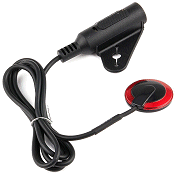 The most common and least expensive pickup type is the piezoelectric. Piezoelectric pickups have a sort of ceramic crystal that generates a weak electrical field when it is stressed by pressure or vibration. They've been around forever (most phonographs before 1970 used piezoelectrics attached to the needle). But in spite of an early Les Paul experiment, they weren't widely used for musical instruments before Barcus Berry's experiments in the mid- to late-1960s.
The most common and least expensive pickup type is the piezoelectric. Piezoelectric pickups have a sort of ceramic crystal that generates a weak electrical field when it is stressed by pressure or vibration. They've been around forever (most phonographs before 1970 used piezoelectrics attached to the needle). But in spite of an early Les Paul experiment, they weren't widely used for musical instruments before Barcus Berry's experiments in the mid- to late-1960s.
Piezos pick up higher frequences better than magnetic pickups, though not as well as microphones. So you can tell the difference between a banjo and mandolin, but you can't necessarily tell the difference between a cheap banjo and a good banjo. Also, their volume is relatively low, and the frequencies they do reproduce are not there in equal amounts, so most professional applications include a preamp with a built in equalizer (tone control). Today most acoustic-electric guitars have battery-powered preamps built right into the guitar. Unfortunately, nobody makes a banjo that way, yet. 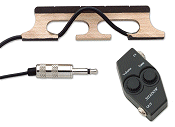
Although Shadow makes a piezo-equipped banjo bridge (shown right), most solutions for banjo are stuck on the underside of the head, so they can pickup the head vibrations, too. My first banjo pickup ever was a one-piece banjo AXL pickup that cost about $17, which I installed in a "pop-top" (aluminum-shell) 6-string that I needed amplifed in a hurry cheap.
The photos below show the inexpensive pickup installed. I ran the output to a $200 guitar amp with no problems, though if I was using it in a more demanding application, I may have used a preamp and/or an "acoustic" amp (which are designed to handle higher frequencies). I would do this to a "beach banjo" again without thinking twice. However for a more expensive banjo, I'd use the Schatten bracket-mount jack assembly shown above, instead of drilling a hole.
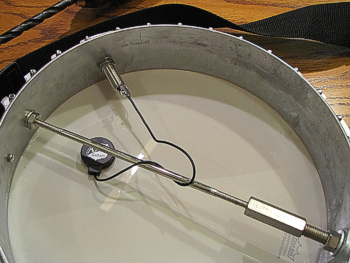 |  |
For more information about piezoelectric pickups, including the installation shown above, click here.
One clear advantage over a standard magnetic pickup is that guitar-style pickups capture only the vibrations of the strings, while the Fishman Rare Earth Banjo pickup actually captures the vibrations of the banjo head, which carry more of the distinctive banjo sound. For many years, this was considered the best-sounding pickup you could put on a banjo. If I ever need to amplify a banjo for a setting that is more demanding than the places I usually play, I would certainly consider one of these.
Incidentally Barcus Berry used to make a very similar pickup, which came with an older Deering banjo I bought on eBay last year. I haven't used it in any really demanding situations yet, so I can't really say how it compares. Except to say that Barcus Berry hasn't supported it for about ten years, so don't go searching for one of these on my account.
My article about the Barcus Berry pickup is here
Rare-Earth Pickups
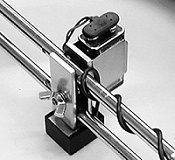 Technically in between the mag coil and the piezo pickup family are the Fishman Rare Earth Banjo Pickup
Technically in between the mag coil and the piezo pickup family are the Fishman Rare Earth Banjo Pickup
that have their own technology. They have preamps that help provide a balanced sound high enough to feed guitar amplifiers, and non-invasive installation. You stick a little metal "shim" onto the underside of the banjo head just "north" of the center foot of the bridge. Then you fasten the pickup itself to the coordinator rods just under the shim. The pickup picks up vibrations from the shim as the banjo's head vibrates and translates them into electrical signals (similar to the magnetic coil pickups I described above). A preamp powered by a 9-volt battery balances out the sound and provides a signal high enough to drive guitar amps, PA inputs, or about anything else you can plug it into. This is probably the most elegant solution, and one of the most expensive, this side of the Kavanjo.
Belt-And-Suspenders Solutions
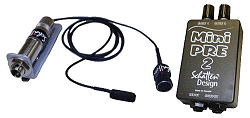 Since my original investigation, a few companies have begun stressing solutions that use both condensor mics and piezos. They have a little mixer that should allow you to rely on the microphone if there's no feedback problem, on the piezo if you're in a feedback prone setting, or somewhere in between if that's what you need. At the time of my original search, these were not available from any reputable company, and they're still the most expensive solution if you buy one from someone who has a track record, like the Schatten
Since my original investigation, a few companies have begun stressing solutions that use both condensor mics and piezos. They have a little mixer that should allow you to rely on the microphone if there's no feedback problem, on the piezo if you're in a feedback prone setting, or somewhere in between if that's what you need. At the time of my original search, these were not available from any reputable company, and they're still the most expensive solution if you buy one from someone who has a track record, like the Schatten
solution shown at the right. I don't know enough people who have used them in enough different situations to recommend them without qualification, but Ovation pioneered a similar solution on a guitar about twenty years ago and it was very effective and realistic-sounding. In theory this should be the best, most effective solution. That said, a number of companies that have no reputation at all have not started making these, so I would recommend going with a provider with a good reputation.
Conclusion
As you can tell, I've dabbled in a number of these solutions. I have to confess that the Kavanjo on my Deering Sierra is the most "bulletproof," solution I've tried, reliable in every way, and not needing any batteries or outboard gear to produce decent sound in almost any situation. It's no wonder that many bands that take banjos on the road seem to prefer this solution.The Fishman Rare Earth pickup seems to have a more realistic banjo sound, so it's a sound choice for soloists or people who play in ensembles where the banjo really has to "shine." To me the simple fact that it requires a battery makes it a "second choice." But most people don't trade off banjos as often as I do, and taking the resonator off to replace the battery isn't really all that hard.
On the other hand, if you are on a very limited budget and you just need your banjo louder, period, a low-end Piezoelectric battery like the AXL unit I used in my article on piezoelectric banjo pickups is better than nothing - and often it's better than trusting the sound guy to turn your banjo's mic to an appropriate level.
If you tend to play in places with scant feedback risks, say house concerts, you might prefer a microphone solution. Or a mic-and-piezo "belt-and-suspenders" solution might be a good dodge. The microphones DO sound better, no question. If you have a professional banjo and you're playing in a place where you can use a mic pickup effectively, the audience will get the best sound your banjo has to offer. They're just not feedback-resistant as other solutions, and that means you may run into issues in jam sessions or loud concerts.
I could have gone down the list of 40 or so individual manufacturers, but with the exception of the Kavanjo and the Fishman Rare Earth pickups, most other brands of mag pickups share the same characteristics, most brands of piezos share the same overall characteristics, and most brands of mic pickups share the same overall characteristics. On top of that, low-end pickup manufacturers come and go so quickly there's almost no point in comparing their individual products against each other. So hopefully this summary approach will give you some good overall guidance.
If you need assistance with specific questions, or if you want to provide any additions, corrections, etc., please contact us.
Best of luck, all, enjoy your music, and carry the flame!
For information about other music topics and projects, check the links at the bottom of this page.
 Whatever else you get out of our pages, I hope you come away with some great ideas for "sharing the joy."
Whatever else you get out of our pages, I hope you come away with some great ideas for "sharing the joy."
And please stay in touch!
All material, illustrations, and content of this web site is copyrighted ? 2001, 2002, 2003, 2004, 2005, 2006,
2007, 2008, 2009, 2010, 2011, 2012, 2013, 2014, 2015, 2016, 2017, 2018 by Paul D. Race. All rights reserved.
Creek Dont' Rise(tm) is a participant in the Amazon Services LLC Associates Program, an affiliate advertising
program designed to provide a means for sites to earn advertising fees by advertising and linking to Amazon.com.
For questions, comments, suggestions, trouble reports, etc. about this page or this site, please contact us.
| Visit related pages and affiliated sites: | |||||
| - Music - | |||||

|
 |
 |

|

|

|

|

|

|

|

|

|

|

|

|

|

|

|
| - Trains and Hobbies - | |||||
 |

|

|  |
 |

|
| - Christmas Memories and Collectibles - | |||||
 |

|
 |

|
 |

|
| - Family Activities and Crafts - | |||||
 |

|

|

|

|

|

